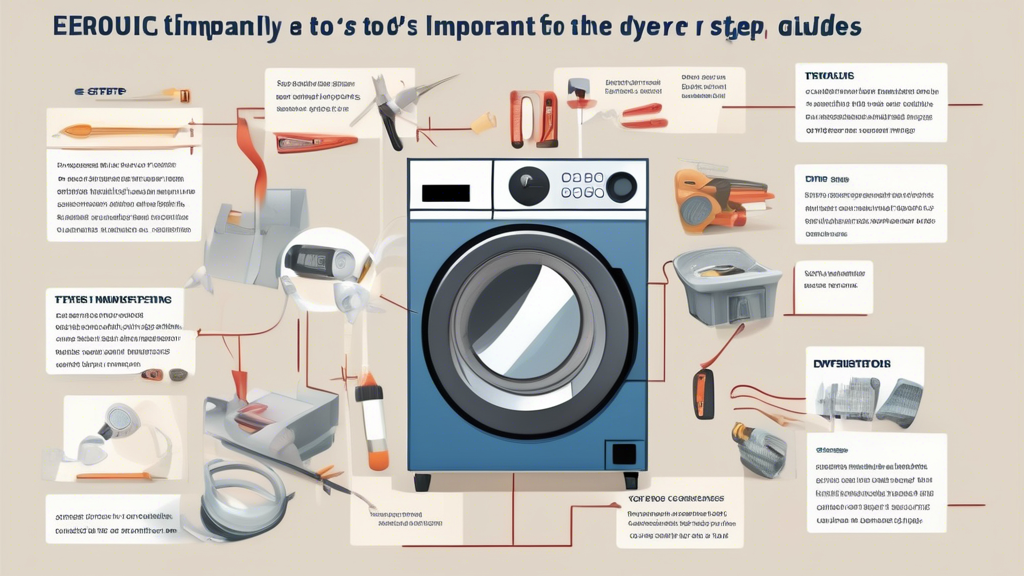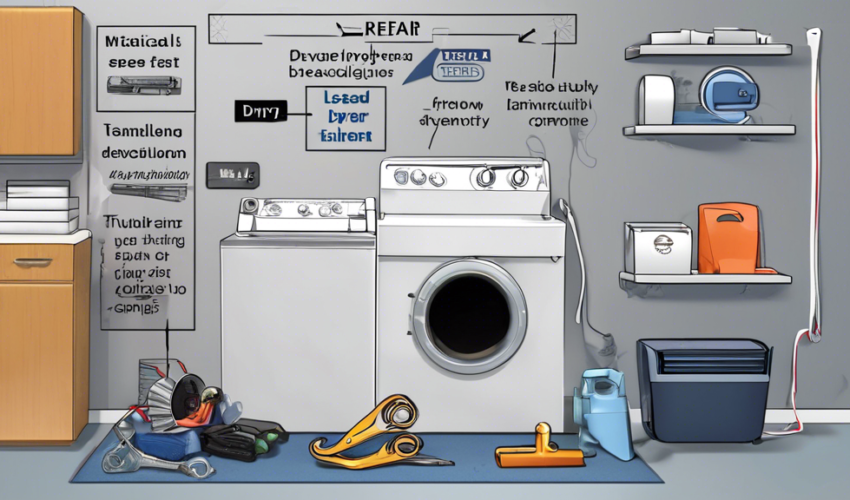Are you tired of dealing with a malfunctioning dryer? Understanding dryer repair is essential for every homeowner, as it can save you time, money, and the hassle of unexpected laundry interruptions. Dryers are a crucial part of our daily routines, and when they malfunction, it can lead to frustration and inconvenience. Common issues include lack of heat, unusual noises, and failure to start, all of which can be alarming if you’re not familiar with the troubleshooting process. In this comprehensive guide, we’ll provide you with step-by-step troubleshooting tips so you can confidently identify and address the symptoms of your dryer’s problems. Additionally, we will delve into DIY checks that can quickly resolve minor issues like power supply disruptions, clogged lint traps, and vent problems, as well as outline when it’s time to call in a professional. Beyond troubleshooting, we’ll also discuss essential maintenance tips that will help you prevent future dryer issues, including regular cleaning and inspections, proper usage guidelines, and a recommended maintenance schedule to keep your dryer running smoothly for years to come. Equip yourself with the knowledge you need to tackle dryer repair head-on and ensure optimal performance for your appliance.
Introduction to Dryer Repair
Understanding dryer repair is essential for every homeowner who relies on this invaluable appliance. A dryer that is functioning properly not only saves time but also enhances the efficiency of your laundry routine. However, when a dryer malfunctions, it can bring an inconvenient halt to your daily activities. Recognizing the significance of learning the basics of dryer repair equips you with the knowledge needed to handle minor issues and know when it’s time to call in a professional.
Common issues with dryers often arise unexpectedly. Some of the typical problems include the dryer not heating, the drum not spinning, unusual noises during operation, or the dryer simply not turning on. Each of these issues can stem from various underlying causes, ranging from simple user errors to more complex mechanical failures. By gaining insight into the common malfunctions, you can better prepare yourself for troubleshooting when your dryer begins to exhibit problems.
The troubleshooting process is the key to addressing any dryer repair needs efficiently. This step-by-step approach involves diagnosing the problem, performing checks, and taking appropriate actions to either fix the issue or determine the necessity for professional repairs. Understanding this process not only gives you the confidence to address many problems but also helps you save time and money by potentially avoiding unnecessary service calls.
The first step in troubleshooting any dryer repair issue is to observe the symptoms carefully. Take detailed notes of what you notice—whether the dryer is making strange sounds, failing to heat, or producing a musty smell. These details can significantly aid in determining the nature of the problem. Common symptoms will guide your next steps in diagnosing the malfunction correctly.
For instance, if your dryer isn’t heating, it could be an issue related to the heating element, a blown thermal fuse, or a malfunctioning thermostat. On the other hand, if the dryer drum isn’t spinning, it may indicate a broken belt, a defective motor, or a faulty door latch. By identifying the symptoms accurately, you can narrow down the potential culprits and expedite the troubleshooting process.
After identifying the symptoms, conducting some DIY checks can often reveal the source of the issue without needing extensive expertise. Start with the essential checks such as ensuring that the dryer is plugged in and that the outlet is functioning correctly. A tripped circuit breaker or blown fuse can lead to the dryer not turning on and might often be overlooked in the troubleshooting process.
Another critical area to inspect is the lint trap and venting system. Excessive lint buildup can obstruct airflow, leading to overheating or even a fire hazard. Remove and clean the lint filter regularly, ideally after each use, and inspect the venting system to ensure it’s clear of blockages. A well-maintained venting system allows your dryer to operate efficiently and reduces the risk of common dryer repair issues.
When faced with unusual noises, such as rattling or grinding sounds, it’s important to conduct a comprehensive inspection. Listen carefully to determine whether the noise is coming from the motor, idler pulley, or roller assemblies. Lack of lubrication or worn parts might require replacement. If you’re uncertain about making these assessments or repairs, consulting the dryer’s manual can provide specific information about parts and maintenance.
If your checks do not pinpoint the issue, or if the problem persists after completing your DIY repairs, it may be necessary to seek professional help. Knowing when to call a technician is crucial because some repairs require specialized training or tools. For instance, if your dryer has electrical issues or requires extensive disassembly, it’s best to defer to professionals who have the expertise to safely resolve complex dryer repair issues without causing additional damage or risking injury.
In summary, understanding dryer repair is incredibly beneficial for maintaining your appliance’s efficiency and longevity. By familiarizing yourself with common issues, symptoms, and basic troubleshooting checks, you can address many problems independently. Moreover, being able to identify when a problem exceeds your capabilities will help ensure that your dryer repair needs are met promptly and professionally. Embracing this knowledge not only saves you time and money but also extends the life of your dryer, ensuring it continues to serve your household reliably.

Step-by-Step Troubleshooting Tips for Dryer Repair
When faced with a malfunctioning dryer, the first step in dryer repair is to clearly identify the symptoms. Pinpointing the specific issue your dryer is experiencing can significantly streamline the troubleshooting process. Common signs of dryer problems include no heat, unusual noises, failure to start, or the dryer running longer than normal. Recognizing these symptoms not only helps in diagnosing the problem but also prepares you for the necessary steps to take next.
Initially Identifying Symptoms
Start by observing the dryer while it operates (or fails to operate). If your dryer is not producing heat, it may be attributed to several factors. Check to see if the drying cycle is running but there’s little to no heat; this could indicate a problem with the heating element or thermal fuse. Similarly, if your dryer is making loud or unusual noises, it often signals a mechanical issue, such as a worn drum belt or faulty rollers. Noting these symptoms will guide your troubleshooting journey in a more focused manner.
DIY Checks
Before jumping to conclusions or calling a technician, there are several DIY checks you can perform to diagnose common dryer issues. Start with the power supply. Ensure the dryer is properly connected to an electrical outlet and that the circuit breaker hasn’t tripped. A simple reset might be all it needs. Additionally, check the power cord for any visible damage or fraying, as this may also prevent your dryer from receiving power.
Next, inspect the lint trap. A clogged lint trap can restrict airflow, leading to overheating and inefficient drying. Remove any lint buildup and wash the lint screen with soap and water if it appears dirty. This simple maintenance task is crucial not just for effective dryer operation but also for fire safety.
Another critical area to check is the ventilation system. Make sure that the vent hose is not kinked and that it’s clear of any obstructions. A blocked vent can cause your dryer to run hot without effectively drying your clothes, which can also result in damage over time. Detach the vent and inspect it thoroughly. A good rule of thumb is to clean your dryer vent at least once a year to ensure optimal airflow and efficiency.
When to Seek Professional Help
While many issues can be resolved through DIY troubleshooting, there are situations where professional dryer repair is crucial. If you have gone through the above checks and your dryer is still not functioning correctly, it may be time to call a technician. This is particularly true if you encounter electrical issues, such as buzzing sounds or burning smells, as these can pose safety hazards.
Additionally, if your dryer is making persistent noises that you cannot identify, or if it continues to run extremely hot, it’s best to contact a professional. Technicians possess the expertise and tools necessary to diagnose and fix complex problems, such as issues with the motor, drum bearings, or the control panel. It’s important to act promptly in these cases to avoid further damage to your appliance and ensure safety for you and your home.
In conclusion, effective troubleshooting is a fundamental aspect of dryer repair. By systematically identifying symptoms, conducting thorough DIY checks, and knowing when to escalate issues to professional help, you can navigate the challenges of dryer repair with confidence. Remember that regular maintenance also plays a vital role in preventing future problems, ensuring your dryer operates efficiently for years to come.

Maintenance Tips to Prevent Future Dryer Issues
Regular maintenance is essential for ensuring the longevity and efficient operation of your dryer. By incorporating a few simple practices into your routine, you can help prevent common dryer issues that could lead to costly repairs. Here are some key maintenance tips that will keep your appliance running smoothly and effectively.
Regular Cleaning and Inspections
One of the most important aspects of dryer maintenance is regular cleaning. Start with the lint trap, which should be cleaned after every use. A clogged lint trap can restrict airflow, making your dryer less efficient and increasing the risk of overheating. In addition to cleaning the lint trap, it’s crucial to inspect and clean the dryer vent and ductwork at least once a year.
A blocked vent can significantly impact the performance of your dryer, leading to longer drying times and potential overheating. To clean the vent, detach it from the back of the dryer and use a vacuum or a specialized dryer vent cleaning kit to remove lint and debris. Ensure that the vent is not excessively long or curved, as this can also impede airflow.
While cleaning, take the time to inspect the dryer and its components for any signs of wear or damage. Look for frayed wires, faulty belts, and any strange smells or unusual noises. By addressing small issues before they escalate, you can avoid dryer repair down the line.
Importance of Proper Usage
Usage plays a significant role in the longevity of your dryer. Always follow the manufacturer’s guidelines regarding load size and drying times. Overloading the dryer can strain its motor and lead to premature wear. For optimal performance, ensure that the dryer is not overloaded, and leave enough space for items to tumble freely.
Additionally, avoid putting damp items in the dryer. While most dryers are designed to handle slightly damp clothing, excessively wet items can cause the dryer to work harder than necessary, leading to longer drying times and higher energy consumption. If clothes are dripping wet, it’s best to wring them out or use a spin cycle on your washer before placing them in the dryer.
Another critical point is to separate heavier items from lighter ones. Towels and blankets can weigh down lighter fabrics, leading to uneven drying and putting stress on the dryer. Drying similar fabrics together helps ensure even drying and reduces wear on the machine.
Recommended Maintenance Schedule for Optimal Dryer Performance
Creating a maintenance schedule can help keep your dryer in top shape. Here’s a simple timeline to follow:
- Monthly: Clean the lint trap after every use and inspect the dryer vent for blockages. Consider vacuuming the dryer drum and exterior to remove any built-up dust.
- Every 3 Months: Check the interior of the dryer vent and ductwork for lint build-up. Tighten any loose connections, and replace any damaged ductwork to ensure a clear airflow.
- Every 6 Months: Perform a thorough examination of the dryer for worn belts, frayed wires, or other components. Also, check the outside vent to make sure it opens when the dryer is in use and is free from obstructions.
- Yearly: Schedule a professional dryer vent cleaning. This is especially important if you use your dryer frequently or have a long vent system.
In addition to these recommendations, consider keeping an eye on your dryer’s performance. Pay attention to any changes, such as longer drying times or unusual noises. Addressing these issues early can help prevent more severe problems and costly dryer repairs down the line.
Conclusion
By implementing these maintenance tips, you can significantly reduce the chances of encountering problems with your dryer. Regular cleaning and inspections, along with proper usage habits, will not only enhance the performance of your dryer but also extend its lifespan. Remember, a well-maintained dryer is a reliable one, so prioritize these tasks to ensure years of effective use.
In conclusion, understanding dryer repair is essential for both efficiency and longevity of this vital household appliance. By familiarizing ourselves with common dryer issues and the troubleshooting process, we can save time, money, and frustration. The detailed step-by-step tips provided equip homeowners with the knowledge to identify symptoms and perform initial DIY checks, such as examining the power supply, cleaning the lint trap, and clearing vents. However, it’s crucial to recognize when a problem might be beyond our skill level and warrants the insight of a professional technician.
In addition to troubleshooting, proactive maintenance is key to preventing future dryer issues. Regular cleaning and inspections not only enhance performance but also reduce the risk of malfunction that can lead to significant repair costs. Proper usage and adherence to a recommended maintenance schedule are vital components that contribute to the overall health and efficiency of the dryer.
Embracing these tips and tricks for troubleshooting will empower you to tackle common dryer problems with confidence, ensuring your appliance operates smoothly for years to come. With a bit of effort in repair and maintenance, you’ll not only extend the lifespan of your dryer but also enjoy consistently reliable laundry days.

